University News
There's No Place Like Home: Housing at WIU
January 16, 2018
By Darcie Dyer-Shinberger '89 MS '98
From the Fall 2017 Western: The Magazine for Alumni of Western Illinois University
MACOMB, IL -- Nearly 104 years ago, Western Illinois University (then Western Illinois State Normal School) built its first residence hall—Monroe Hall, a three-story building that served as the women's residence hall for many years.
Monroe Hall (later renamed Grote Hall), also known as "the Women's Building" opened in December 2013 (Editor's Note: See "Blast from the Past" on page 8 to read about Monroe/Grote, as well as the first men's dorm, Seal Hall). According to "First Century: A Pictorial History of Western Illinois University" by English Professor Emeritus John E. Hallwas '67 MA '68, Dean of Women Caroline Grote ran a tight ship in her oversight of Monroe Hall. From the 1914 Sequel: "What Miss Grote Knows: What church we go to—or don't. The boys who smoke—and shouldn't. Where we are every night. What no one else knows. What Miss Grote Doesn't Know: Give it up."
Betty (Ross) McKinley ‘57 MS.Ed. ‘67 was a resident of Grote Hall in the mid-1950s, and remembers the Grote Rules quite well.
"Freshmen had to be in by 9 p.m. on weeknights and by 10 p.m. on weekends. We did get an extra half hour after programs on campus. Our upper classmates had 10 p.m. weeknight curfews, but we all had to sign out and in during the evening. There were no hours for the men as they figured having the women corralled, they would all go home to study," McKinley said.
Dining was conducted "family style" and the residents had assigned seating in the dining room. Seating was changed around every few weeks so the residents of Grote had the opportunity to get to know everyone. One night a week, on Wednesdays, dinner was a "dress up" affair.
"Someone would stand at the entrances to the dining hall to check that no one with bobby socks could enter. Those of us who arrived almost late would just take off our socks and stuff them somewhere to get in," she laughed. "I was told that years prior the residents had to wear formals on the dress up night."
While Wednesdays were considered "formal meals," breakfast time was another matter. McKinley remembers a loud buzzer would sound to announce breakfast was ready, so they would arrive in their slippers and bathrobes, going back to the kitchen to select their breakfast and sitting where they liked for the morning meal.
In addition to the strict curfews and dining room rules, each floor in Grote had a proctor whose job was to keep things quiet during designated study hours. That same resident also worked the front room one night each week, ensuring everyone had signed back in for the night, outside doors were locked and that dates kept both feet on the floor in the front room and the hallway (where the "neckers" would go).
"On weekends, athletes would come into the dorm to perform janitorial duties. They were to holler ‘man on three' or whatever floor they were on. Sometimes you'd hear the girls call out ‘Where? Where?," McKinley recalled. "My years at Western, and in Grote, were a joy most of the time. I made very close ties with three other women and we continue to this day. I received an excellent education that prepared me well for the future, and, I met my husband, Bill."
McKinley worked in education, teaching students from kindergarten all the way through the graduate level. She taught in Jacksonville, IL; Park Forest, IL; Macomb and at WIU. While her husband was in graduate school in Colorado, she worked for the Mountain Prairie Girl Scout Council, covering Ft. Collins, Loveland, Berthoud and Estes Park. After moving to Billings, MT, she taught part-time at Rocky Mountain College, and while there, she was a part of a Career Opportunity Program training teachers on the Crow and Northern Cheyenne Indian Reservations. The couple eventually moved back to Illinois, where McKinley taught part time and volunteered in the schools. In 1999, the McKinleys moved to Sheridan, WY.
Lloyd Simonson '66 transferred to WIU in 1964, after he obtained his associate degree from Wright Junior College of Chicago. His first residence hall experience was on the next to highest floor of Washington Hall.
"For someone not comfortable with heights, I was somewhat unnerved. After meeting and becoming friends with students living in Seal Hall, I decided that was a better place for me," he said. "Everything was convenient there and third floor was the highest floor in the building. I absolutely loved living in Seal Hall and eventually became an RA."
Simonson added that Seal Hall was "almost like a fraternity without the letters."
"We had some great intramural sports teams and always rooted for Seal Hall teams when playing all the lesser dorms. I was a sports legend—in my own mind—since I was a starter on the Wright JC basketball team. I played there under Coach Badger, who became the head coach of the Bulls. However, at WIU I began to realize that I should get serious about studying since I would never be a pro basketball or baseball player. In fact, I had a better chance of getting struck by lightning," he said.
Simonson majored in biology at WIU, and went on to earn a master's and doctoral degrees. He worked as a scientist at the Naval Institute for Dental and Biomedical Research in Great Lakes, IL for 34 years, and was the inventor or co-inventor of 13 U.S. Patents.
Another Seal resident, Thom "Kahuna" Cornelis '70, who had a long career as a sports anchor and director, remembers his first day on Seal 1.
"The RA [Bill O'Toole '68] took me over to the field to practice for intramural football," he said. "I dubbed our floor ‘Toole's Tornadoes' and we had game jerseys that were the envy of the dorm. The bonding of all the Seal guys was evident from day one. It was like having a fraternity on campus."
Cornelis recalled one highlight was Seal 1 versus Seal 6 in the dorm football finals.
"My 'clean' block on Gordy Taylor led to the game-winning touchdown thrown by Doc Canady. To this day, Mr. Taylor is still griping that he was given a cheap-shot clip," Cornelis laughed. "Thanks for the great memories!"
John (JB) Biernbaum, associate vice president for student services-student life, has been involved in the residential side of life on WIU's campus for 23+ years.
"I have always thought residence halls are real, living, breathing things. They are not just four walls and a roof; not just a place to eat and study," he said. "Our halls have certainly been much more than those things. They have given birth to inspiration and dreams, and watched some of them shattered as well. They've started careers. People met their future spouses and forever friends. First loves were found. Students figured out what they wanted to do with their lives [at least some did]. Our halls have given us nurses, polices officers, firefighters, teachers, and business leaders. They've housed individuals who have gone on to tremendous successes over their course of their life. Students made foolish mistakes and learned from them. Sadly, some even died within our halls. Life and learning happen and the world is a better place for it."
On the eve of the Higgins Hall implosion weekend in early July 2017, Biernbaum reminisced about housing at WIU in the 1960s.
"When Higgins was born, there were house phones instead of cell phones. Residents gathered in the lounge for various community events instead of being tethered together though social media. Television sets were a luxury, not an expectation. Those televisions had three channels, not 300," he said. "Students ate together as a floor in the dining room (and had food fights) instead of getting take out and going back to their single rooms. There were panty raids and various other shenanigans. Streaking and curfews and dress codes were commonplace; things today we would never dream of dealing with or implementing."
Garry Johnson, vice president emeritus for student services at WIU, came to WIU in 1980 as the director of residence life.
"When I came here from the University of Missouri-Columbia, I was surprised how advanced the use of technology was in what was then called Student Residential Programs," Johnson said. "Dr. Dale Meador was a master of finding new ways to use our existing technology in everyday operations and student recruitment."
Johnson noted that WIU's residential programs have been trendsetters over the years. For example, because of Western's seamless move-in process, many universities across the nation have developed similar processes because former WIU housing staff bring that experience with them. Johnson continued his many years of move-in experience this year as a volunteer during Move-In Weekend Aug. 18.
During his time at Western, which spanned nearly 20 years, Johnson provided guidance and sage advice to hundreds of future housing professionals. Student Services, UHDS (University Housing and Dining Services) and the CSP (College Student Personnel) Program have turned out a significant number of housing professionals over the years who have gone on to do great work on college campuses across the country.
Phyllis McCluskey-Titus '79 MS '81, who lived in Wetzel for two years, followed by a two-year stint as a resident assistant in Higgins, and eventually serving as an assistant hall director in Tanner, said living on campus was "the most amazing experience."
"I met nearly all of my very good friends [to this day] by living and working in campus residence halls, and living on campus even got me started on a career in housing/student affairs that I never knew existed when I came to campus in 1975," McCluskey-Titus, a professor in the college student personnel administration graduate program at Illinois State University, added.
When she lived in Wetzel in the late 1970s, it was the University's newest hall. It had air conditioning, carpeted rooms and was co-ed, with men living on the north side of the building and women on the south side.
"We had a lot of activities including floor parties [with kegs and grain alcohol punch], Wetzel Week and Welcome Week that had trivia and dance contests, window painting, talent shows, volleyball, basketball, tug of war competitions, and outside barbecues," she reminisced. "There was a real sense of community as we walked across Q-Lot for classes in the cold and very snowy 1970s winters [literally NO ONE had cars back then] … we walked everywhere!
"We all shared 'party lines' with the hard-wired phones in our rooms and had to make plans to meet up for meals as the cafeteria was open only certain times and each floor had their designated tables where everyone ate together," she added.
It was McClusky-Titus' graduate assistant supervisor in Higgins, when she was serving as an RA, who suggested she might want to think about a career as a housing professional, something McCluskey-Titus said she had never considered. Upon enrolling in the CSP program at WIU, she became the assistant hall director, and during her first year in 1979, McClusky-Titus and hall director Lisa Schulte were the only two women in the hall.
"After a semester closure, Tanner had reopened late in Summer 1979, with an overflow of freshmen male students … all assigned to Tanner. It was a challenging year with a lot of discipline cases and vandalism, but the staff grew close and worked hard together," she recalled. "I try to instill in my graduate students a love of working in campus residence halls. There are opportunities for learning and growth by living on-campus that are unmatched in other experiences."
----
Students Stage Panty Raids – Macomb Journal, May 23, 1952
Panty raiders, men students of Western, swarmed into Grote Hall, a sorority house, and one women's rooming house last night. At two other sorority houses they failed to gain entrance.
The window in a third-floor fire escape door and a kitchen window were broken at Grote Hall.
At the sorority house which the students entered, the supervisor floored one raider with a chair, and her husband smacked another with the butt of a gun as he tried to climb in a window. This offense routed the invaders.
Some coeds taunted the attacking parties and invited them to break in. Other girls armed themselves with whatever weapons could be improvised.
City and state police, sheriff's officers, and city firemen were called, and they restored order by about 1 a.m. The situation had been out of hand for about two hours.
Tear gas was used to disperse men students, described by police as "running wild" through Grote Hall ...
Reports on the number of men involved ranged from 50 to 200.
----
A Look Back at Housing History
Excerpts from "First Century: A Pictorial History of Western Illinois University"
by English Professor Emeritus John E. Hallwas
May 1911: Plans underway for the first women's residence hall.
1943: The Monroe Hall Annex, located at 907 W. Adams St., opened.
Summer 1946: Veteran's Village, which was originally comprised of three former Army barracks from Camp Cutler in Michigan, was first established behind Monroe Hall to house male students. Ten additional barracks from Missouri and Louisiana were acquired and placed where Corbin and Olson now stand. The additional barracks were divided into small apartments to primarily house married students. The rent was $28.50 a month.
1947: Monroe Hall's name was changed to Grote Hall in honor of Caroline Grote, and an addition was built.
1949: A new wing was built on to Grote Hall, providing 28 double-occupancy rooms.
1954: Seal Hall was built as a first residence hall for men on the site of the old football field. This was the marker of the now two standing residence halls that comprised WIU's on-campus housing. Each resident paid $60 per quarter.
Summer 1958: The "barracks" are demolished.
Summer 1958: Bennett and Hursh complex opened, housing 176 women and 128 men, respectively. The residence hall system had begun to grow and flourish.
1959: Inter-Hall Council founded. The council was comprised of representatives from each hall, and was responsible for some of housing policies on campus.
1960: The first modern married housing complex, University Village, was completed at a cost of $225,000. When the 31 one-bedroom apartment building opened, Veteran's Village was demolished.
September 1962: Corbin Hall was erected during the building boom of President A.L. Knoblauch's tenure. The eight-story hall, named for Mabel L. Corbin, cost $2.8 million and was move-in ready for 800 female students.
1963: Lincoln and Washington halls, aka the "twin towers," were completed. The 14-story buildings held 1,014 male students.
1965: Olson Hall, once referred to as "Corbin's Twin," was completed in 1965, at a cost of $3 million. Named for Corbin's close friend, Blenda Olson, it housed 602 women. While still under construction, Olson Hall was dedicated Nov. 22, 1964.
1966: Bayliss and Henninger halls are completed at the northeast corner of campus. Bayliss housed 507 men, while Henninger housed 507 women. Together they cost $5.7 million.
1966: East Village, a 74-unit apartment building for married students, was completed. It was dedicated May 18, 1968.
Fall 1966: Construction began on the $7.3 million 20-story Higgins Hall, a residence hall for women. Higgins was built on the seventh hole of the old golf course. Higgins opened in Fall 1967.
Fall 1968: Tanner Hall opened. The 16-story building cost $6.75 million. A barrier kept the male and female wings separate.
Fall 1969: Thompson Hall opened. The $6.5 million building housed 1,234 men and women in separate wings on 19 floors.
September 1970: The 13-story Wetzel Hall opened, housing 824 men and women.
Fall 1970: Lamoine Village, a 232-unit married housing complex opened.
1971: The first truly co-ed residence hall was the predominantly female Higgins Hall, which set aside a few floors for men.
1972/1973: Grote Hall closed.
1975: An open cafeteria proposal was written by Inter-Hall Council to allow residents to eat in any cafeteria on campus. Previously, students were restricted to dining in the hall in which they resided.
1991: Grote Hall was demolished.
1993: Bennett, Hursh, Lincoln, and Washington halls closed.
Fall 1995: After extensive renovations, Lincoln and Washington halls reopened to offer single-occupancy rooms.
1998: Hursh Hall was demolished.
2004: The new Caroline Grote Hall opened on the site of the former Bennett Hall.
Fall 2009: Tanner Hall became a First Year Experience residence hall.
Fall 2009: Wetzel Hall was taken off-line.
Summer 2010: Lamoine Village building one taken off-line.
May 2012: Lamoine Village buildings two and three taken off-line.
July 14, 2012: Wetzel Hall demolished by implosion.
August 2012: Corbin and Olson halls reopen after an extensive two-year renovation project.
May 2013: Higgins Hall taken off-line.
Summer 2013: Thompson Hall undergoes renovations.
Spring 2015: East Village taken off-line.
Spring 2017: East Village demolished.
July 2017: Higgins Hall demolished by implosion.
Posted By: University Communications (U-Communications@wiu.edu)
Office of University Communications & Marketing


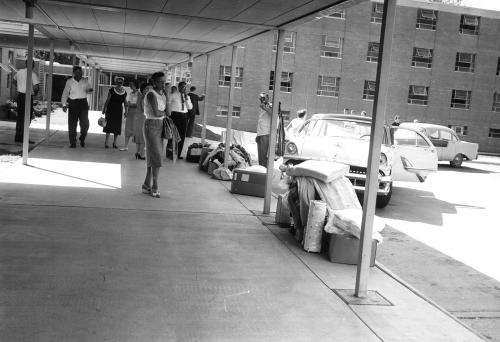
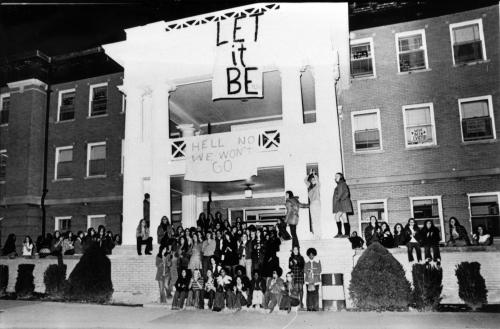
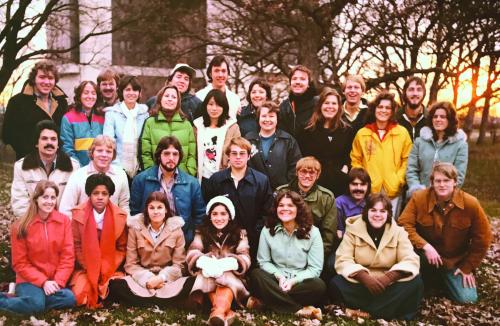
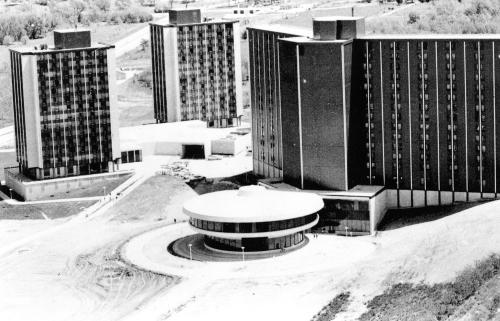
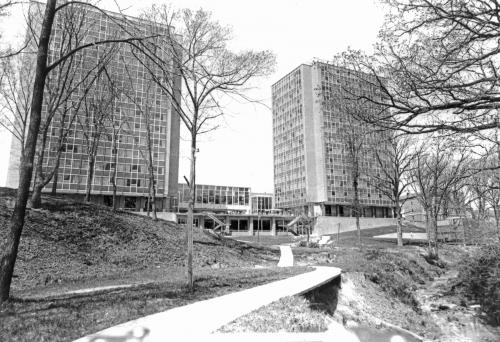
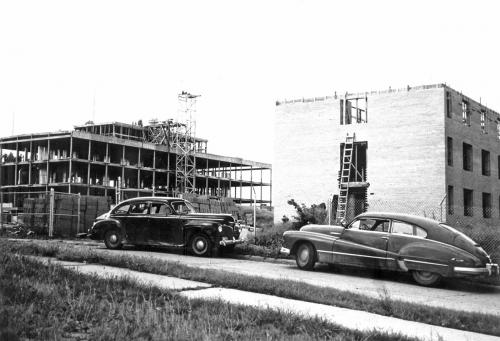
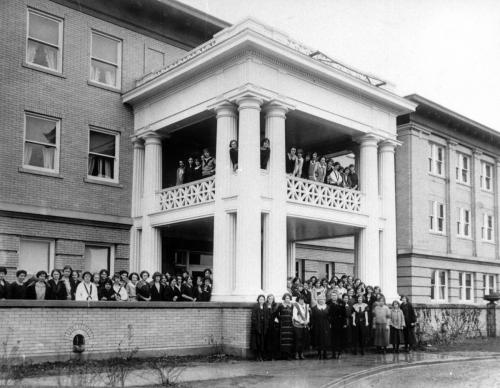
Connect with us: